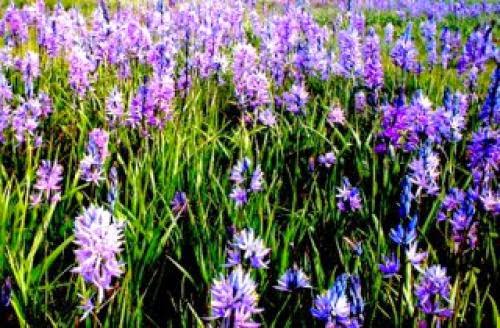
In a couple of days Summer Solstice/Midsummer will be here. For us in Montana and the rest of the Mountain Time Zone it will be at 11:46 pm, Saturday night, June 20, 2009. To determine the exact time where you are, check out the June Solstice 2009 article on EarthSky.
This is one of the big days for many traditions and religions around the world. This period of the year marks the Sun's greatest increase and triumph
For the Celtic Druids, it is "Alban Heruin" ("Alban Hefin" in modern Welsh). This is usually translated as "the Light of the Shore" as this date is between Alban Eiler ("Light of the Earth"- Spring Equinox, when the Earth is awakening) and Alban Elued ("Light of the Sea" Fall Equinox, - when the Sun is descending into the Sea). Vervain (verbena) was the holy herb of this day. Many consider this day under Belinus, hero-god of fire and the Sun, and Lugh, the sun-hero. For those of Arthurian bent, it is the day of Sir Gawain and Lady Ragnall (John Michael Greer's "The Druidry Handbook", 2006); also see The Three Realms, AODA, and OBOD.
For the Germanic and Norse Heathens of Northern Europe, including Asatru, it is a time to honor Sunna and Baldr in "blot" (ceremonial feasting), all night outdoors, with the same focus on the height of the sun and its life-giving power, the greening growth of the land. Check out the Asatru Alliance for example; one of my favorite Heathen resources is Uncle Thor's Blog.
For Catholics, midsummer's day was marked by the Feast of St. John the Baptist. With the shift in the calendar, this moved from solstice on June 21 to June 24, the same that Christmas Eve/Christmas moved from winter solstice on Dec. 21 to Dec. 24-25. As with other feasts in Europe, this day was picked to overlay/co-opt/transform the pagan festivals of midsummer. this day did not mark St. John's death, but his birth, and bonfires and other pagan survivals marked this day, although cast in different terms by the Church. See more at Midsummer's and the Festivals of St. John and the Catholic Encyclopedia's article on St. John the Baptist.
For bioregional animists, one takes one's cues mostly from the local environment. The wasps and bees are out in force, and the birds are fussing over the eggs in their nests. The flowers of many plants are in transition. The fruit tree blossoms are gone, the lilacs are in steep decline, and roses are beginning to bloom.
Midsummer marks the Sun's triumph in his ascent to the highest point in the Sky; but of course that triumph is always brief, for the highest point cannot last and the descent towards fall begins right after it. This is a lesson of life: that the highest point brings descent, and the lowest point brings ascent. Mountains are defined by valleys, and valleys by mountains.
In Montana, the Native American tribes were not agriculturalists. Instead they followed the bison's movements and the ripening of wild plant foods, so they did not mark the time by festivals and solstices in the same way as Europeans or even other tribes in other parts of the U.S. However there were certain very important wild plants that were harvested now (and some folks still do this), and in June in the hills around the Helena Valley and the rest of western Montana this was the time of gathering and roasting Camas (Camassia quamash) (important! don't confuse it with the death-camas!) for the Salish (Flathead), with attendant feasting and happiness.
JUNE - THE MONTH OF THE CAMAS
Camas plants have a bulbous root that is usually ready for harvest in June. Camas bulbs are baked with black moss in earthen pits for three days. After baking, the bulbs were dried and stored for later use. Baked camas is delicious and has a licorice like flavor. During this time people would also be making bark baskets from cedar and birch trees. The baskets would be used for berry picking. Tipi poles would be cut now, as the bark would peel easy. When the wild roses were in bloom, the people would know that buffalo would be nice and fat. Salish hunting parties would then travel to the plains country for their summer buffalo hunt. http://www.anamp.org/culturally/pdf/elem weather.pdf
The Blackfeet also gathered camas at this time but focused more on the buffalo.
The buffalo migrated to the open grassy plains in the early summer, the time known to the Blackfeet as the "moon of flowers." The people followed the buffalo to the Cypress Hills or other hunting grounds in the eastern region of their homeland where they would stay only as long as the buffalo. The summer hunts provided the ceremonial buffalo-bull tongues needed for the Medicine Lodge, or Sun Dance Ceremony, during the moon when "serviceberries were ripe". http://www.trailtribes.org/greatfalls/camp-life-and-seasonal-round.htm
The camas here grow in higher elevations, and I have not been able to see any this year. I did see buffalo as I noted in an earlier post. I am thinking about some ways to celebrate Summer Solstice by strengthening connections with my three friends here in my neighborhood: Tree, Hill, and Gulch. I will put out some traditional offerings to the land at Tree and the Gulch in the afternoon, and will go up on the Hill and light a candle (since bonfires are out of the question here!) in the evening sometime. This is a time for the wights, the landvaettir, the faerie, the nature spirits and Mother Earth herself. June is the best and most fragrant and magical month in my neighborhood.
I will be giving the next Ghost Walk on Friday, so come on over to the north steps of the Lewis and Clark Country Courthouse on Broadway at 8 pm and join us!







